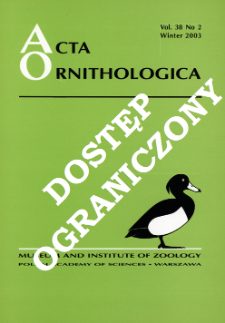
Object
Title: The mechanism of feather movements: implications for the evolution of birds and avian flight
Subtitle:
Acta Ornithologica, vol. 34, no. 2 ; Mechanika ruchu piór: odniesienia do ewolucji i lotu ptaków
Contributor:
Polska Akademia Nauk. Muzeum i Instytut Zoologii ; Meeting of the European Ornithologists' Union (2 ; 1999 ; Gdańsk)
Publisher:
Muzeum i Instytut Zoologii PAN
Place of publishing:
Description:
Referat wygłoszony na Second Meeting of the European Ornithologists' Union ; Bibliogr. p. 139-140 ; P. [135]-140 : ill. ; 27 cm ; Abstract in Polish
Type of object:
Abstract:
The feather-bearing skin of birds differs fundamentally from the fur-bearing skin of mammals. Especially within the feather tracts, it contains much structural fat tissue in the dermis and the subcutaneous Fascia superficialis. These are separated from each other by an elastic membrane and are, together with the feather muscles, part of the hydraulic skeleto-muscular apparatus of the feathers. While feathers are raised by erector feather muscles and are returned to their resting position by the resilience of the surrounding fat tissue and an elastic membrane, the depressor feather muscles counteract external forces, such as air turbulences, thereby ensuring a smooth surface of the coat of feathers and reducing drag during flight. The coat of feathers itself creates fusiform body contours, which also reduce drag. Furthermore, subcutaneous fat bodies are strategically placed to ensure an even draping of the skin over the body and, thereby, contribute to streamlined body contours. The subcutaneous fat bodies and the dermal depressor muscles are part of the unique characteristics of the avian integument and have evolved under the selective regime for streamlining of body contours and surface as a precondition for the evolution of avian flight.
Relation:
Volume:
Issue:
Start page:
End page:
Detailed Resource Type:
Format:
Resource Identifier:
Source:
MiIZ PAN, call no. P.257, Vol. 34, No 2 ; MiIZ PAN, call no. P.4568, Vol. 34, No 2 ; click here to follow the link
Language:
Rights:
Rights Reserved - Restricted Access
Terms of use:
Digitizing institution:
Museum and Institute of Zoology of the Polish Academy of Sciences
Original in:
Library of the Museum and Institute of Zoology of the Polish Academy of Sciences
Projects co-financed by:
Programme Innovative Economy, 2010-2014, Priority Axis 2. R&D infrastructure ; European Union. European Regional Development Fund
Access:
Object collections:
- Museum and Institute of Zoology PAS > Scientific Journals
- Museum and Institute of Zoology PAS > MIZ PAN Publications > Acta Ornithologica
Last modified:
Oct 2, 2020
In our library since:
May 20, 2014
Number of object content downloads / hits:
70
All available object's versions:
https://rcin.org.pl/miiz/publication/61242
Show description in RDF format:
Show description in RDFa format:
Show description in OAI-PMH format:
| Edition name | Date |
|---|---|
| Mechanism of feather movements: implications for the evolution of birds and avian flight / Homberger, Dominique G. | Oct 2, 2020 |
Objects Similar
Lebreton, Jean-Dominique (1950– )
Tieleman, Bernardine Irene Williams, Joseph B.
Orzech, Wojciech.
Lokki, Heikki Saurola, Pertti (1938– )
Kania, Wojciech Maria (1943– ) Busse, Przemysław (1937– )
Aebischer, Nicholas J.

 INSTYTUT ARCHEOLOGII I ETNOLOGII POLSKIEJ AKADEMII NAUK
INSTYTUT ARCHEOLOGII I ETNOLOGII POLSKIEJ AKADEMII NAUK
 INSTYTUT BADAŃ LITERACKICH POLSKIEJ AKADEMII NAUK
INSTYTUT BADAŃ LITERACKICH POLSKIEJ AKADEMII NAUK
 INSTYTUT BADAWCZY LEŚNICTWA
INSTYTUT BADAWCZY LEŚNICTWA
 INSTYTUT BIOLOGII DOŚWIADCZALNEJ IM. MARCELEGO NENCKIEGO POLSKIEJ AKADEMII NAUK
INSTYTUT BIOLOGII DOŚWIADCZALNEJ IM. MARCELEGO NENCKIEGO POLSKIEJ AKADEMII NAUK
 INSTYTUT BIOLOGII SSAKÓW POLSKIEJ AKADEMII NAUK
INSTYTUT BIOLOGII SSAKÓW POLSKIEJ AKADEMII NAUK
 INSTYTUT CHEMII FIZYCZNEJ PAN
INSTYTUT CHEMII FIZYCZNEJ PAN
 INSTYTUT CHEMII ORGANICZNEJ PAN
INSTYTUT CHEMII ORGANICZNEJ PAN
 INSTYTUT FILOZOFII I SOCJOLOGII PAN
INSTYTUT FILOZOFII I SOCJOLOGII PAN
 INSTYTUT GEOGRAFII I PRZESTRZENNEGO ZAGOSPODAROWANIA PAN
INSTYTUT GEOGRAFII I PRZESTRZENNEGO ZAGOSPODAROWANIA PAN
 INSTYTUT HISTORII im. TADEUSZA MANTEUFFLA POLSKIEJ AKADEMII NAUK
INSTYTUT HISTORII im. TADEUSZA MANTEUFFLA POLSKIEJ AKADEMII NAUK
 INSTYTUT JĘZYKA POLSKIEGO POLSKIEJ AKADEMII NAUK
INSTYTUT JĘZYKA POLSKIEGO POLSKIEJ AKADEMII NAUK
 INSTYTUT MATEMATYCZNY PAN
INSTYTUT MATEMATYCZNY PAN
 INSTYTUT MEDYCYNY DOŚWIADCZALNEJ I KLINICZNEJ IM.MIROSŁAWA MOSSAKOWSKIEGO POLSKIEJ AKADEMII NAUK
INSTYTUT MEDYCYNY DOŚWIADCZALNEJ I KLINICZNEJ IM.MIROSŁAWA MOSSAKOWSKIEGO POLSKIEJ AKADEMII NAUK
 INSTYTUT PODSTAWOWYCH PROBLEMÓW TECHNIKI PAN
INSTYTUT PODSTAWOWYCH PROBLEMÓW TECHNIKI PAN
 INSTYTUT SLAWISTYKI PAN
INSTYTUT SLAWISTYKI PAN
 SIEĆ BADAWCZA ŁUKASIEWICZ - INSTYTUT TECHNOLOGII MATERIAŁÓW ELEKTRONICZNYCH
SIEĆ BADAWCZA ŁUKASIEWICZ - INSTYTUT TECHNOLOGII MATERIAŁÓW ELEKTRONICZNYCH
 MUZEUM I INSTYTUT ZOOLOGII POLSKIEJ AKADEMII NAUK
MUZEUM I INSTYTUT ZOOLOGII POLSKIEJ AKADEMII NAUK
 INSTYTUT BADAŃ SYSTEMOWYCH PAN
INSTYTUT BADAŃ SYSTEMOWYCH PAN
 INSTYTUT BOTANIKI IM. WŁADYSŁAWA SZAFERA POLSKIEJ AKADEMII NAUK
INSTYTUT BOTANIKI IM. WŁADYSŁAWA SZAFERA POLSKIEJ AKADEMII NAUK
































